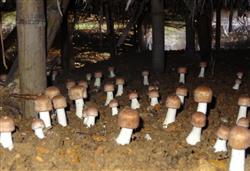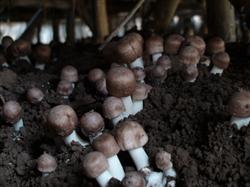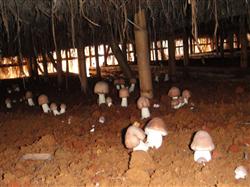Planting techniques of Agaricus blazei Murrill: how to grow Agaricus blazei Murrill?

How to grow Agaricus blazei Murrill? Please introduce the method of planting Agaricus blazei Murrill can refer to the following planting methods: ㈠ planting material Agaricus blazei Murrill the most suitable planting material is bagasse. It can also be planted with rice straw, wheat straw, cottonseed hull, corn stalk, thatch, sawdust and so on. In one or more of the above mixed raw materials, some cow dung (horse manure), poultry and a small amount of chemical fertilizer are added appropriately. With reference to the cultivation technology of Agaricus bisporus, the culture material suitable for the growth of Agaricus blazei Murrill was made after accumulation, fermentation and turning. ㈡ planting season according to the biological characteristics of Agaricus blazei Murrill, the planting season is generally arranged in late spring, early summer and autumn. It was planted before and after the Qingming Festival in spring (March-May) and after the Beginning of Autumn in autumn (September-November). Low altitude areas can be extended to sow seeds from April to May and harvest mushrooms from June to July. In short, it is necessary to master that after sowing, when the mushroom begins to produce after 40 ℃ 50 days, it is better that the temperature can reach 20 Mui 28 min. The climate conditions are different in different places, so the sowing date should be controlled flexibly. ㈢ planting technology Agaricus blazei Murrill strain also denominator seed, original seed, planting seed three levels, according to the Agaricus bisporus seed production method. PDA medium is used for mother seed, and wheat grain medium is generally used for original seed and planting seed. 1. Build a pile to soak straw or cottonseed hulls such as rice straw and cottonseed hulls. After pre-wetting, they are fully stirred with rice bran, sawdust, livestock and poultry manure and other raw and auxiliary materials. The width of the stack is 80ml / 90cm. two。 The pre-pile turning time is about 7 days, and the first turn-over should be carried out when the material temperature rises to 70 ℃ or so. Ammonium sulfate or urea was added to the culture material when turning the pile, and with the help of microorganisms, it was fermented into an available nitrogen source for Agaricus blazei Murrill. During the pre-stack period, the fermentation in the middle layer of the material pile is better, and the material temperature is higher, but the surrounding culture materials are not fully fermented. When turning the pile, it should be fully mixed, the middle culture material should be turned on the periphery, and the peripheral culture material should be piled to the center of the pile. The second turn was carried out after 5 days, and then turned at intervals of 4 days, 4 days and 3 days (a total of 5 times, fermentation time 23 Mel 25 days). In order to ferment evenly inside and outside the material pile, the middle culture material should be turned out and the outer layer culture material should be piled into the middle when turning the pile. After fermentation, the culture material turns brown, the hand-pulled fiber is easy to break, and the fermentation is completed. The water content of the culture material after composting fermentation is about 60-75%. When the pH value is on the high or low side, it can be adjusted with superphosphate or hydrated lime. In order to produce uniform, fully mature and high-quality culture materials, pile turning is a very important process and should not be careless. 3. Feeding and making bed Agaricus blazei Murrill can be planted indoors and outdoors. When growing indoors, you can set up a bed with 4mur6 floors, or you can use the empty mushroom room and bed to lay the mushroom bed evenly and loosely with a thickness of 20cm. After the culture material went to bed, the "secondary fermentation" was carried out, that is, the entrances and vents of the mushroom room were closed, the temperature of the mushroom room was raised to 55 ℃ and 60 ℃, and kept for about 2 days. Planting in the field is carried out under the shade shed, with a width of 1.3 meters and arbitrary length. The height of the shade is 2mi 2.3 meters, the roof and the surrounding are shaded by grass curtains and shading nets (four yang and four yin are required), the border bed is shaped like a tortoise, the middle is slightly higher than that around, and a good drainage ditch is opened. If planted in the mountains, flood control ditches should be opened. The surface of the bed was sprayed with chemical pesticides to kill pests. Then spread the fully mature culture material on the border bed, the thickness of which is generally 20ml 25cm (according to the dry material, about 16mur20kg of culture material is needed per square meter). 4. Sowing and management: break the wheat seed gently, sprinkle it evenly on the culture surface, shake it properly with a fork, sprinkle it on the bed, and finally cover it with a culture material of about 1 centimeter. The sowing rate is 1-2 bottles per square meter. After outdoor planting and sowing, the border bed should be covered with plastic film to keep warm and humid. Generally speaking, it is not necessary to uncover the plastic film or spray water within 5 days after sowing, and the film is ventilated on the 6th day. The relative humidity of the air is 85-90%. If the material surface is dry, it should be sprayed with water to moisturize. Under normal circumstances, it is ventilated every 2 days. Indoor planting should also pay attention to the changes of temperature and humidity in the mushroom room. Do a good job of heat preservation and moisturizing, and make more fresh air into the mushroom room, do not make the mushroom room feel muggy every day. 5. The time of covering soil was to see that the mycelium of Agaricus blazei Murrill survived in the culture medium. Generally, about 20 days after sowing, the hyphae grow to 2 / 3 of the whole culture material and begin to cover the soil. The quality of soil particles covered with culture material and the method of covering soil have great influence on the yield of Agaricus blazei Murrill. Therefore, soil mulching is a very important work in planting. The soil particles used for covering soil should not be too hard, and large soil particles without fertilizer, fresh, water retention and good aeration performance are the best. In China, the soil at the bottom of the field is generally selected, and the water content is 70-75%. The cover of soil can be tiled or "gear". That is, first cover the material surface with a layer of soil particles about 1 cm thick, and make a mound with a width of 10 cm and a height of 5 cm at intervals of 10 cm to 15 cm, with a thickness of about 3 cm 4 cm. Planting in the field should be arched with bamboo bars on both sides of the bed, and then covered with plastic film to make it grow in the microclimate. The temperature in the cover film should not exceed 30 ℃, if it is too high, the film should be released to cool down, and the relative humidity should not be less than 85%. 6. Management of mushroom production whether the management during the period of mushroom production is appropriate or not will result in a substantial increase or decrease in yield. Therefore, it must be managed carefully. The mycelium of Agaricus blazei Murrill began to produce mushrooms after the spread of the culture material. Generally, about 40 days after sowing, the hyphae developed sturdily, and a small amount climbed to the upper layer. At this time, water should be sprayed on the border bed, and the relative humidity in the film should be 90-95%. After keeping the film for 2 days, white rice-shaped mushroom buds will appear on the soil surface, and then grow into soybeans. 3 days later, when the mushroom buds grow to 2m in diameter, water spraying should be stopped to avoid causing mushroom (bud) body deformities, which is the key to water management. During mushroom production, a large amount of oxygen is consumed and carbon dioxide is discharged, so we must pay great attention to ventilation during mushroom production, uncover the film once or twice a day for not less than 30 minutes, and continue to cover and moisturize the mushroom bud after ventilation. promote the normal growth of mushroom buds. Overcast and rainy weather can lift the cover around the film for ventilation to prevent mushroom buds from rotting. The best temperature for mushroom emergence period is 20 ℃ and 25 min. If sown in early spring, the temperature is on the low side when the mushroom is produced, the film can be tightly protected and moisturized, and the ventilation time and times can be shortened. When the temperature exceeds 28 ℃ in early summer, you can thicken the shade on the shade and open the film all day to ventilate and ventilate, creating a cooler climate. When planting indoors, we should also pay attention to the sunshade of doors and windows, and ventilation in the morning and evening. The mushroom production cycle is about 10 days. After the mushroom production is over, the shape of the border can be modified, and then water can be sprayed to replenish the moisture of the border bed to prepare for the next mushroom production. Mushroom production can last for 4 months, and it can be harvested one by one (usually 4mur5 batches). Well water or spring water should be used for spraying water. 7. The suitable harvest time for harvesting and processing Agaricus blazei Murrill is the mushroom bud stage just before the cap leaves the stalk, that is, the cover has not yet opened the umbrella, the surface is brown, there are fibrous scales, and it is suitable to harvest when the bacterial membrane in the inner layer of the fold has not been broken. If the bacterial membrane is ruptured, the spores on the fold will gradually mature, and the fold will turn black after drying, reducing the commercial value. Fresh mushrooms after harvest can be processed by preservation or salinization. If it is dried, it should be dried according to the customer's requirements, some are dried in the dryer, some are cut in half from the cover to the handle, and the finished products are dried. Dry products smell fragrant, bacteria pleated white, packed in transparent plastic bags, outer packing in cardboard boxes or according to customer requirements. Pest control: Agaricus blazei Murrill has the ability to resist miscellaneous bacteria, almost no damage to bacteria. However, we should pay great attention to ventilation and make the mushroom room and border too wet. Harmful bacteria are often found before and after covering the soil, and it is best to burn them with a blowtorch when they occur. The pests of Agaricus blazei Murrill include mushroom fly, mushroom moth, nematode and so on. If the post-fermentation is complete, it can almost prevent the occurrence of pests. If pests occur, they can be burned with a blowtorch or fumigated with aluminum phosphide when Agaricus blazei Murrill does not occur or stops occurring. Click to get more planting techniques of Agaricus blazei Murrill
- Prev

Planting techniques of Agaricus blazei Murrill: how to grow Agaricus blazei Murrill?
How to grow Agaricus blazei Murrill? Please introduce the method of planting Agaricus blazei Murrill can refer to the following methods: 1, the stacking of culture materials. ⑴ cultivation raw materials. Formula 1: 42% of rice straw, 42% of cottonseed hull, 7% of cow dung, 6% of wheat bran, 1% of phosphate fertilizer, 1% of calcium carbonate, 1% of potassium dihydrogen phosphate, plus 70% of the total water of raw materials. The formula.
- Next

Planting technique of Agaricus blazei Murrill: what is Agaricus blazei Murrill?
What is Agaricus blazei Murrill? Please introduce Agaricus blazei Murrill, also known as Agaricus blazei, which belongs to basidiomycetes subphylum, lamellae, Agaricus, Mushroom family and Mushroom genus. It is a related species of Agaricus bisporus, so its biological characteristics are more similar. Agaricus blazei Murrill is a Japanese trade name, meaning Pleurotus ostreatus. In fact, Agaricus blazei Murrill regardless of its shape and flavor, and.
Related
- Fuxing push coffee new agricultural production and marketing class: lack of small-scale processing plants
- Jujube rice field leisure farm deep ploughing Yilan for five years to create a space for organic food and play
- Nongyu Farm-A trial of organic papaya for brave women with advanced technology
- Four points for attention in the prevention and control of diseases and insect pests of edible fungi
- How to add nutrient solution to Edible Fungi
- Is there any good way to control edible fungus mites?
- Open Inoculation Technology of Edible Fungi
- Is there any clever way to use fertilizer for edible fungus in winter?
- What agents are used to kill the pathogens of edible fungi in the mushroom shed?
- Rapid drying of Edible Fungi

